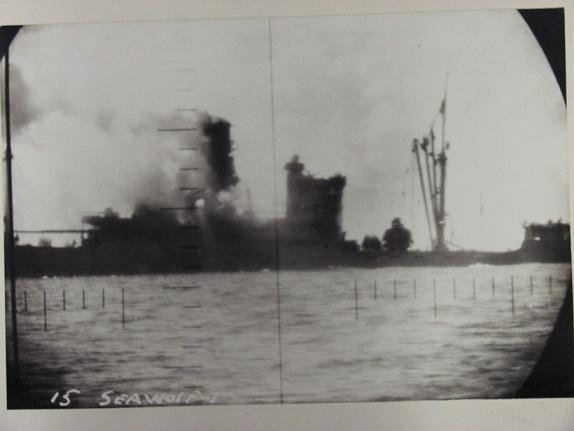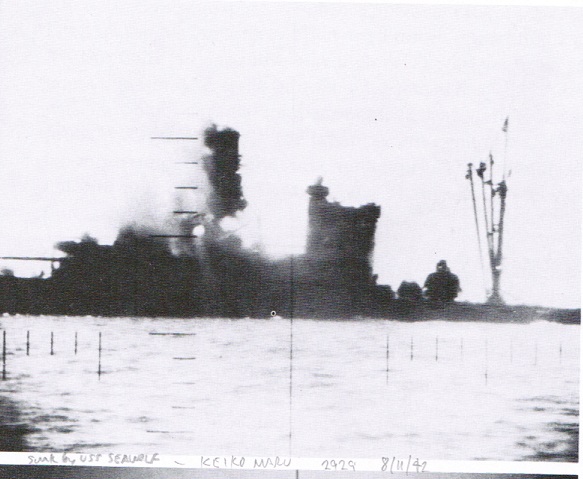KOKAI HOKAN!
 (KEIKO MARU, sinking)
(KEIKO MARU, sinking)
IJN KEIKO MARU:
Tabular Record of Movement
© 2023 Gilbert Casse, Berend van der Wal and Peter Cundall
19 January 1938:
Uraga. Laid down by Uraga Senkyo K.K. Uraga Kojo as a 2,929-tons cargo passenger ship for Osaka Shosen K.K.
18 July 1938:
Launched and named KEIKO MARU.
15 October 1938:
Completed and registered at Osaka with a Gross Registered Tonnage (GRT) of 2,929-tons and a Net Registered Tonnage (NRT) of 1,671-tons. Her call sign is JFUM. [1]
7 November 1938:
Inauguration of the North Chosen (Korea) Express line: Kobe, Kanmon, Seishin, Chosen (now Chongjin, North Korea), Rashin (also known as Rajin or Rason), Chosen (now Rason, North Korea), Unggi (Yuki), Chosen (now Sonbong County, North Korea).
7 November 1938 ~ 2 August 1941:
In service on the North Chosen Express Line.
1 November ~ 10 November 1939:
Undergoes an intermediate inspection.
14 August 1941:
Requisitioned by the IJN.
5 September 1941:
Registered as an auxiliary gunboat attached to the Sasebo Naval District under order No. 1025. Rated as an auxiliary gunboat engaged in minelaying under instruction No. 1026. Navy Capt Kawana Takeo (34) is appointed CO that same day.
1 October 1941:
Navy (Resv) LtCdr. Azuma Tsuneji is appointed CO.
15 October 1941:
Attached to the 1st Gunboat Division under order No. 1250. Tactically attached to Vice Admiral Takahashi Ibo’s (36) Third Fleet in Rear Admiral (later Vice Admiral) Kubo Kyuji’s (38) First Base Force, 1st Gunboat Division. Navy (Resv) LtCdr Azuma Tsuneji is confirmed as CO.
23 November 1941:
Innoshima. Conversion for military duty is completed at Osaka Tekkojo K.K. shipyard.
8 December 1941:
At Koniya, Amami Oshima.
17 December 1941: Invasion of Lamon Bay, Southern Luzon, Philippines:
Imperial General Headquarters launches the combined IJA and IJN Lamon Bay Operation. The Army force consists of Gen (later Field Marshal) Count Terauchi Hisachi’s Southern Expeditionary Army. Its 14th Army, under LtGen Homma Masaharu, fields MajGen Morioka Susumu's Invasion Unit of about 7,000 troops consisting of elements of the 16th Infantry division: 20th Infantry, 22nd Field Artillery, HQ and II Battalion, 16 HQ Coy, 16th Eng Battalion, 16th Recon Battalion, 3/45 AA Coy, 16th Transport, 16th Signal Coy, 16th Med Unit and 16th Vet Unit. Two AA and one Signals Regiment are stationed on IJA transports (Yusosen).
The invasion units are embarked on 20 IJA transports: BENGAL, DAINICHI, DURBAN, KAIMEI, KAYO, KITANO, KOFUKU, LISBON, NAGATO, NICHIREN, RYOKA, RYUYO, SHINSEI, SHINSHU (4,182 GRT), TAIAN, TATSUNO, TOFUKU, TOYAMA and TOYOHASHI MARUs and TAMON MARU No. 5.
The naval force consists of Vice Admiral (later Admiral) Kondo Nobutake's (35) (former CO of KONGO) Southern Force, Philippines Invasion Group that includes Vice Admiral Takahashi Ibo’s (35) (former CO of YAMASHIRO) Third Fleet. Rear Admiral (later Vice Admiral) Kubo Kyuji’s (38) (former CO of KAGA) Invasion Unit consists of his 1st Base Force HQ, in light cruiser NAGARA, 1st Quartermaster Ports and Docks Unit and 1st Naval Signal Unit, aboard HAKUSAN MARU, 1st Naval Guard Unit, aboard KIMISHIMA MARU, 1st Naval Survey Unit in SENKO MARU and Captain (later Vice Admiral) Mori Kunizo's (40) (former CO of SATA) Sasebo No. 1 and 2 Combined Special Naval Landing Force (SNLF) aboard MYOKO MARU.
The convoy’s escort consists of light cruiser NAGARA (F), heavy cruiser ASHIGARA, destroyers TOKITSUKAZE, YUKIKAZE, KAWAKAZE, SUSUKAZE, UMIKAZE, YAMAKAZE, minelayer AOTAKA, minesweepers W-7 and W-8, auxiliary gunboat/minelayer IKUSHIMA MARU, auxiliary gunboats BUSHO, KEIKO, KANKO and MYOKEN MARUs, auxiliary subchasers SHONAN MARU No. 17 and TAKUNAN MARU No. 5 and auxiliary netlayer FUKUEI MARU No. 15.
Departs Koniya with the Invasion Force.
24 December 1941:
Arrives at Lamon Bay, Philippines.
26 December 1941:
At 0900, departs Lamon Bay with BUSHO, KANKO and MYOKEN MARUs and Patrol Division 21 escorting minelayer AOTAKA and others.
1 January 1942:
Arrives at Palau, Eastern Carolines.
3 January 1942:
Departs Palau.
8 January 1942:
Arrives at Malalag Bay, Philippines.
10 January 1942:
Departs Malalag Bay and arrives at Davao, Mindanao, Philippines later this day.
22 January 1942:
Departs Davao.
26 January 1942:
Arrives at Banka, Celebes, Netherlands Indies. (Now Sulawesi, Indonesia).
1 February 1942:
Attached to Vice Admiral Sugiyama Rokuzo’s (38) Third Southern Expeditionary Fleet 32nd Special Base Force, 1st Gunboat Division.
2 March 1942: Invasion of Zamboanga, Mindanao, Philippines:
Covers the landing at Zamboanga with gunboat Division 1's BUSHO MARU, light cruiser KUMA, torpedo boat KIJI, subchaser Division 51's KYO MARU No. 13 and seven of Air Group 32's reconnaissance seaplanes.
3 March 1942:
At 0240, the invasion force arrives off Zamboanga. Special Naval Landing Forces (SNLF) land on the beach one kilometer W Zamboanga. During the night, counter-attacks are made by small units. IJN escort vessels open fire to neutralize the opposition. The city is cleared before sunset. An SNLF unit from KUMA rescues about 80 Japanese nationals who had been interned. After embarking the civilians on board, KEIKO MARU, the SNLF troops return to KUMA and depart Zamboanga.
10 April 1942:
Removed from 1st Gunboat Division under order No. 652. Attached to Vice Admiral Takahashi Ibo’s (36) Southwest Area Fleet in Vice Admiral Sugiyama Rokuzo’s (38) Third Southern Expeditionary Fleet, 32nd Special Base Force.
November 1942:
Engaged in clearing islands near Surigao Strait. These consist of Bucas Grande Is, Siargeo Is, Panaon Is, Dinagat Is, Homonhon Is, and Suluan Is.
8 November 1942:
While sailing on a round trip from Davao hit by three torpedoes fired by LtCdr. (later Rear Admiral) Frederick B. Warder's (USNA '25) USS SEAWOLF (SS-197). She sinks at 06-24N, 125-59E, about 13.5 nautical miles WNW Cape San Augustin, Mindanao, Philippines, possibly lost with all hands. At least two periscope photos of the stricken and sinking vessel are taken before USS SEAWOLF leaves the area. (See above and below).
30 November 1942:
Removed from the Navy’s list under Instruction No. 2198.
 (Detail of KEIKO MARU, sinking)
(Detail of KEIKO MARU, sinking)
 (Further periscope view of KEIKO MARU, sinking)
(Further periscope view of KEIKO MARU, sinking)
Authors' Notes:
[1] NRT is a ship's cargo volume capacity expressed in "register tons", one of which equals to a volume of 100 cubic feet (2.83 m3). It is calculated by subtracting non-revenue-earning spaces i.e. spaces not available for carrying cargo, for example engine rooms, fuel tanks and crew quarters, from the ship's gross register tonnage (GRT). Net register tonnage (NRT) is not a measure of the weight of the ship or its cargo, and should not be confused with terms such as deadweight tonnage or displacement.
Thanks go to Gengoro S. Toda of Japan.
- Gilbert Casse, Berend van der Wal and Peter Cundall.
Back to the Auxiliary Gunboats Page







